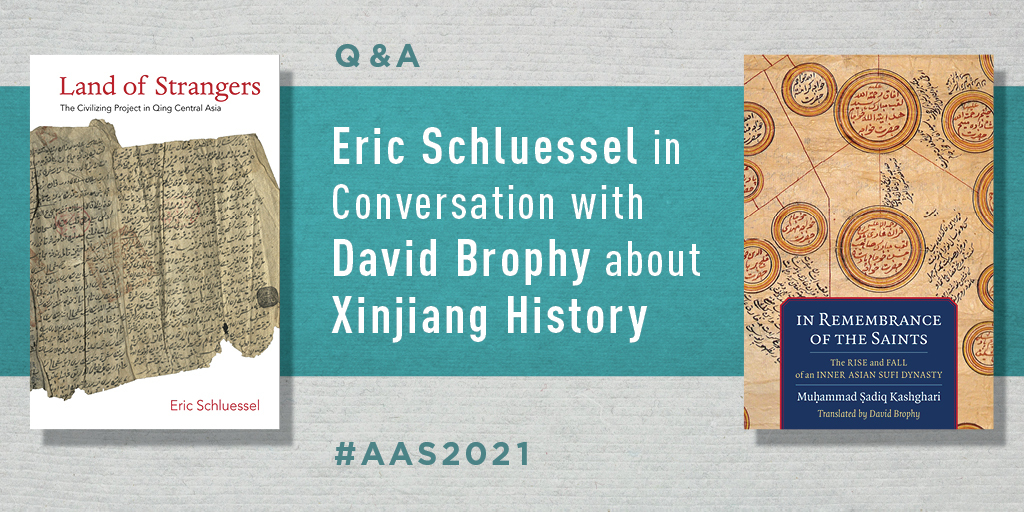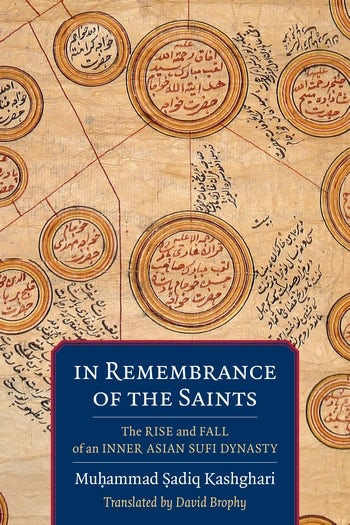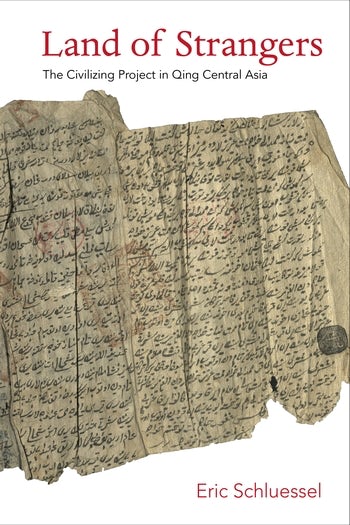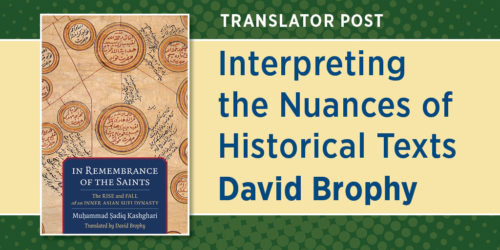Eric Schluessel in Conversation with David Brophy about Xinjiang History

Columbia University Press has published two groundbreaking new books on Xinjiang history, David Brophy’s In Remembrance of the Saints: The Rise and Fall of an Inner Asian Sufi Dynasty and Eric Schluessel’s Land of Strangers: The Civilizing Project in Qing Central Asia. The authors sat down to discuss sources, methods, and what these books mean for our understanding of Xinjiang today.
Eric Schluessel: In Remembrance of the Saints is a translation of the Tadhkira-i ʿAzizan, a work of Chaghatay literature that centers around a Sufi factional struggle in the Uyghur homeland in the eighteenth century. What can today’s reader learn from In Remembrance of the Saints? Are there any misconceptions that you’ve been able to clear up by studying it?
David Brophy: We often think of the Qing invasion of Xinjiang as the arrival of non-Muslim rule in a Muslim land, but this text depicts a half century of interaction between Islamic elites and the non-Muslim Junghars before that Qing invasion. The picture we get here, both of conflict and of collaboration, is really helpful in understanding what came next. On a more specific note, engaging with this text led me to revise the traditional view of Sufi sectarianism in this period. It was actually the political crisis described in this work—the fall of the Junghars and the arrival of the Qing—that reshaped existing divisions into what became known as the White Mountain / Black Mountain rivalry. Scholars have mistakenly equated this with other lines of division, giving us an ahistorical, unchanging picture of the history of Sufism in the region.
ES: We are experiencing a wave of translations of texts from the Uyghur homeland into English. What is the value of these translations? How does translation help us rethink our understanding of the region?
DB: There’s a lot of interest in Xinjiang these days—from undergraduates and from the wider public—but there aren’t a lot of resources for people to develop that interest. Translating a whole text rather than simply mining it for data allows us to ask more complicated questions about the ideologies at work in a period, the intellectual resources available to an author, the intentions of a patron, etc. We can also look at the large body of known manuscripts—more than twenty in this case—for hints as to how Kashghari’s work was received and revised. Judging from those manuscripts, this was the most popular account of a cataclysmic period in the region’s history, so while it’s a source for the events it describes, it can also shed light on the way people in Qing Xinjiang made sense of this transition.
ES: I know that you were working on this translation for many years. What inspired you to undertake this project? What kinds of challenges did you encounter along the way?
DB: Looking back, this was the first manuscript I seriously engaged with, so my first motivation was the challenge of doing that. I came to really enjoy the narrative, though, particularly in the second half, where it has the feel of a historical novel. Given the shortage of resources in the Xinjiang field, I’ve always felt a certain responsibility to make works like this accessible to a wider audience as a way of building the field. Along the way I spent a lot of time grappling with philological issues, but I’ve tried to present it here without a huge technical apparatus. Working a fairly literal, cautious first pass into something more readable wasn’t an easy task.
DB: Let’s turn to Land of Strangers. Land of Strangers is the most in-depth study we have of late-Qing Xinjiang. It’s also really the first local history of a Xinjiang oasis in English. What were some of the things that felt new or surprising to you as you wrote it?
ES: The book is focused tightly on the oasis of Turfan at the end of the nineteenth century. We tend to think of this as the period that first defined the conflict between the Muslim people of Xinjiang and Chinese rule. But the archive told stories about shifting boundaries, changing loyalties, and ambiguous relationships among members of communities trying to live with one another or simply survive. On a macro level, it pointed to the shifting perspective that Muslim writers had on Qing rule—how some argued that it had once been good and just and now seemed to be aggressive and tyrannical. I was surprised to find, at the heart of this swirling discourse of difference, conflicts surrounding intimate relationships that led to deeper anxieties about descent, family, and the boundaries of community.
DB: You open up a level of analysis that’s often hard for historians of Xinjiang—or of anywhere in China, really—to get to. That’s in large part because of the local archives that you’re using. Can you talk about the opportunities and limitations of this source base?
ES: Land of Strangers places two kinds of sources into dialogue: manuscripts in the Chaghatay language (the precursor to modern Uyghur) and archival documents from Turfan that are mainly in Chinese. Those documents are invaluable for their level of detail, but they are also quite clearly replete with misunderstandings, deceptions, and sometimes intentional fictions. When I studied how documents from legal cases recorded in the Turfan archive were edited, it became clear that the same cases as presented in the First Historical Archive in Beijing were radically altered, and to such a degree that the Beijing documents were totally unreliable as sources for local history. So it was necessary to make translation the subject of my research. I looked closely at how Chaghatay-language documents based on assumptions from an Islamic textual tradition were transformed into documents that were not just in Chinese but tailored to the perceived expectations of Chinese officials. That allowed me to better understand how writing for the authorities was interconnected with the broader Turkic Muslim manuscript culture, which addresses more fully how people regarded Chinese power. Once this politics of representation was becoming clearer, it was more possible to read the archives “against the grain” and explore the social changes and tensions inscribed within them.
DB: It’s obviously hard to think about the “civilizing mission” in Xinjiang without thinking of the present. Are the policies you study in this book and their effects comparable to the situation today? Are there any lessons we can take from this history?
ES: The “civilizing project” described in this book was rooted in a very specific community of Chinese activist scholars who cultivated a specific strand of the Neo-Confucian tradition that was sometimes at odds with the wishes of the Qing court, so it would be difficult to draw a straight line from 1877 to today. Those activists attempted to build Muslims’ affinity for what they saw as transcendent truths and really wanted to effect a transformation of teaching, rather than of ethnicity. I refer to this as a project of turning “Muslims into Confucians,” riffing on “peasants into Frenchmen.” The idea was to create a morally good agrarian society, made up of stable families, and transform the borderland into an inalienable part of the Chinese civilizational ecumene. Of course, the result was the opposite of what they intended—instead of assimilating Muslims, the provincial leaders of Xinjiang merely alienated them further.
It’s very different in that sense from the situation in Xinjiang today, where a nationalizing state, enabled by advanced technology, characterizes Uyghurs as “spiritually polluted” and isolates them in camps in order to “cure” them. What these two periods share, however, is a crisis of identity, of what it means to be Chinese, and consequently an attempt to transform internal Others according to shifting ideals of Chineseness. This new project is unlikely to work as intended—like the civilizing project of the late Qing, it is rooted in a sense of crisis, and it misidentifies the roots of conflict.
Eric Schluessel is assistant professor of modern Chinese history at the George Washington University, and David Brophy is a senior lecturer in modern Chinese history at the University of Sydney. You can save 20 percent their books and any AAS featured title when you use coupon code AAS at checkout now through May 1, 2021.










